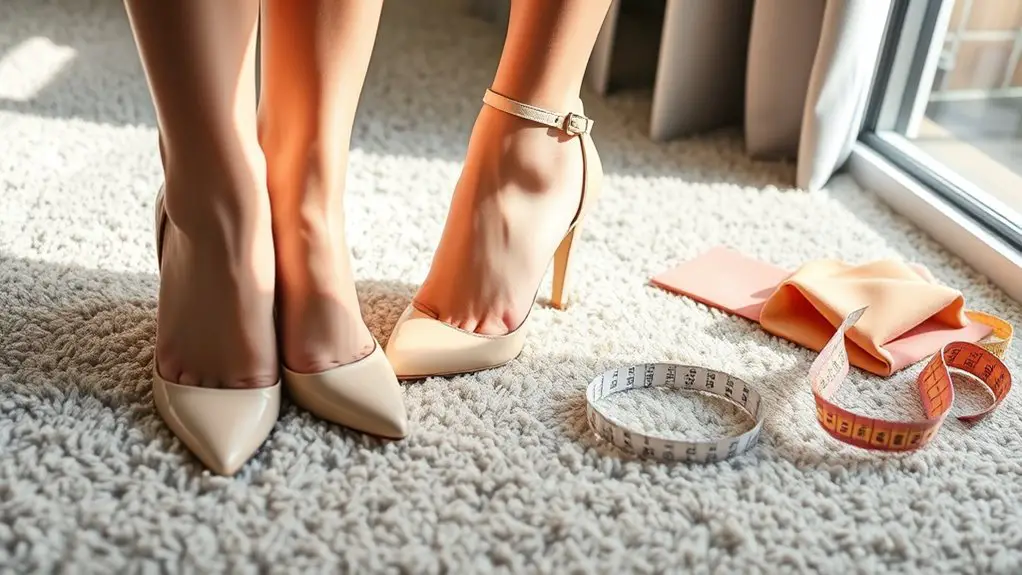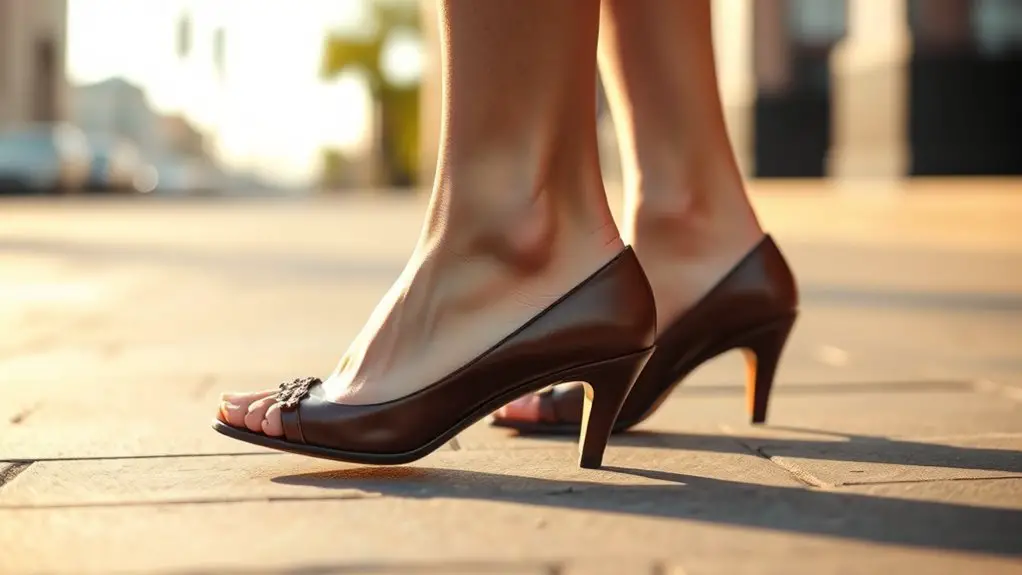To walk in heels without pain, start by choosing the right pair—opt for lower heels and rounded toes for comfort. Prepare your feet with stretching and strengthening exercises, like toe raises and ankle rotations. Focus on maintaining good posture; stand tall, engage your core, and keep your weight evenly distributed. Take smaller steps and practice heel-to-toe motion for balance. Finally, incorporate foot care techniques, like massages, to enhance comfort. There’s more helpful advice to discover on this topic.
Choosing the Right Heels

Choosing the right heels can make all the difference in your comfort and confidence. When selecting heels, pay close attention to heel height and toe shape. A lower heel, around 2-3 inches, is often more comfortable for extended wear, especially if you’re new to heels. As you gain confidence, you might experiment with higher heels, but make certain they provide adequate support.
Toe shape is equally important. Pointed toes can create a sleek look but may pinch your feet, especially if you have wider feet. Opt for rounded or almond-shaped toes for a more comfortable fit, as they allow more space and reduce pressure.
Always try on heels and walk around in them before making a purchase. Remember, the right pair should not only match your outfit but also feel good on your feet. Comfort and style can go hand in hand when you make informed choices!
Preparing Your Feet
Before slipping into your favorite pair of heels, it’s crucial to prepare your feet to prevent discomfort and blisters. Start with some foot stretching exercises to enhance flexibility and reduce tension. Simple stretches like toe raises and ankle circles can work wonders.
Next, focus on toe alignment. Proper alignment prevents excessive pressure on specific areas, which can lead to pain. Here’s a quick reference table for effective foot preparation:
| Exercise | Description | Duration |
|---|---|---|
| Toe Raises | Stand tall, lift toes. | 10 reps |
| Ankle Circles | Rotate ankles in both directions. | 30 seconds |
| Calf Stretch | Lean against a wall, stretch calves. | 30 seconds |
| Foot Roll | Use a tennis ball to massage the arch. | 2 minutes |
Incorporating these practices into your routine will set your feet up for a more comfortable experience in heels.
Mastering Your Posture

To walk confidently in heels, you’ve got to master your posture. Start by aligning your spine, which not only supports your body but also enhances your overall appearance. Engaging your core and relaxing your shoulders will help you maintain balance and poise, making it easier to strut your stuff.
Align Your Spine
Mastering your posture is essential for walking confidently in heels, and aligning your spine plays a key role in this process. Start by standing tall with your feet hip-width apart, allowing your spine to align naturally. Keep your shoulders back and down, as this helps create a straight line from your ears to your hips. Pay attention to the heel height of your shoes; higher heels can increase the strain on your back. Make certain your weight is distributed evenly across your feet, which assists in maintaining proper spinal alignment. As you walk, visualize a string pulling you upward from the crown of your head, encouraging a straight spine and reducing discomfort. This alignment will enhance your grace and confidence in heels.
Engage Core Muscles
Engaging your core muscles is essential for maintaining stability and balance while walking in heels. Proper core engagement helps support your spine and enhances muscle stability, reducing discomfort. Here are four practical tips to enhance your core engagement:
- Stand Tall: Maintain an upright posture, ensuring your shoulders are aligned with your hips.
- Breathe Deeply: Inhale deeply to activate your diaphragm, which supports core muscles.
- Tighten Your Abs: Gently pull your belly button toward your spine, engaging your abdominal muscles.
- Focus on Your Hips: Keep your hips level and stable, avoiding unnecessary swaying as you walk.
Relax Your Shoulders
Walking in heels can feel like a balancing act, but relaxing your shoulders is key to achieving a graceful posture. Tension in your shoulders can lead to discomfort and disrupt your balance. To combat this, practice relaxation techniques such as deep breathing or shoulder rolls. Here’s a quick reference table to help you identify signs of shoulder tension and corresponding relaxation techniques:
| Signs of Shoulder Tension | Relaxation Techniques | Tips |
|---|---|---|
| Tightness in shoulders | Deep breathing | Inhale through the nose |
| Pain or discomfort | Shoulder rolls | Roll back and down |
| Stiffness | Neck stretches | Tilt head side to side |
| Forward slouching | Arm stretches | Reach overhead |
| Fatigue | Mindfulness exercises | Focus on your body |
Incorporating these methods can enhance your overall comfort in heels.
Taking Small Steps

While it might feel tempting to stride confidently in heels, taking small steps is vital for maintaining balance and stability. By adopting a smaller stride, you’ll find it easier to shift your weight and control your pace, reducing the risk of discomfort or falls. Here are some practical tips for mastering small steps in heels:
- Engage Your Core: A strong core helps you maintain balance while walking.
- Focus on Your Foot Placement: Position your feet directly beneath your hips to guarantee proper alignment.
- Practice Heel-to-Toe Motion: Land on your heel first, then roll through to your toes for a smoother gait.
- Keep Your Eyes Forward: Looking ahead, rather than down, helps you maintain your balance and control your pace.
Practicing Balance
Mastering balance is essential when you’re learning to walk in heels, and a few key practices can make all the difference. Start by incorporating balance exercises into your routine. Simple activities like standing on one foot or practicing yoga can greatly enhance your stability. You might also try using a balance board or stability ball to engage your core muscles, which are vital for maintaining balance while walking in heels.
Another effective method is stability training. This includes exercises that challenge your proprioception, like walking heel-to-toe in a straight line. Gradually increase the difficulty by doing these exercises on uneven surfaces or while wearing your heels. As you improve, you’ll find that your confidence grows, and walking in heels becomes much more comfortable. Remember, consistency is key, so make balance practice a regular part of your preparation for wearing heels.
Incorporating Foot Care Techniques
To truly enjoy wearing heels, you need to prioritize foot care alongside your footwear choices. Selecting the right shoes can make a significant difference in comfort and support, so consider factors like fit, arch support, and heel height. Additionally, incorporating daily foot exercises can strengthen your feet, improve flexibility, and reduce discomfort when you step out in style.
Proper Footwear Selection
Choosing the right heels is essential for both comfort and style, especially if you want to avoid foot pain and long-term damage. To guarantee you make the best selection, consider these factors:
- Shoe Materials: Opt for breathable materials like leather or suede that allow your feet to stay cool and comfortable.
- Heel Height: Choose heels that you can walk in confidently; lower heights (2-3 inches) are better for stability.
- Cushioning: Look for shoes with adequate padding in the insole to absorb shock and reduce pressure.
- Arch Support: A design with built-in arch support can help distribute weight evenly, preventing discomfort.
Daily Foot Exercises
Incorporating daily foot exercises into your routine can make a significant difference in your comfort and stability while walking in heels. Start with toe stretches: while seated, extend your toes and hold for 10 seconds, then release. Repeat this 5 times for each foot to improve flexibility.
Next, perform ankle rotations. Sit comfortably and lift one foot off the ground. Rotate your ankle clockwise for 10 reps, then counterclockwise for another 10. This strengthens your ankles and enhances balance.
Remember to massage your feet after these exercises, focusing on any tight areas. Regularly practicing these simple techniques not only helps in alleviating discomfort but also prepares your feet for the demands of wearing heels. Your feet will thank you!
Frequently Asked Questions
How Long Does It Take to Get Used to Walking in Heels?
Getting good at walking in heels takes time. Typically, you’ll find the adaptation process lasts a few weeks with consistent heel training. Practice gradually, and soon you’ll strut with confidence and comfort!
What Heel Height Is Best for Beginners?
For beginners, a heel height of 1 to 2 inches is ideal. It offers stability while allowing you to adjust to different heel types. Remember, choosing comfortable shoes is key for your confidence and balance.
Can Certain Foot Shapes Affect Heel Comfort?
Absolutely, your foot shape affects heel comfort. If you’ve got a high arch, look for shoes with a supportive toe box. Finding the right fit can make a huge difference, ensuring comfort while wearing heels.
How Often Should I Take Breaks While Wearing Heels?
You should take breaks every hour when wearing heels, ideally for about 10-15 minutes. During these breaks, lower your heel elevation to relieve pressure and allow your feet to rest and recover effectively.
Is It Okay to Wear Heels Every Day?
Wearing heels daily isn’t ideal due to potential heel impact on your feet. If you choose to wear them every day, consider alternating styles and incorporating supportive insoles to minimize discomfort and maintain foot health.



